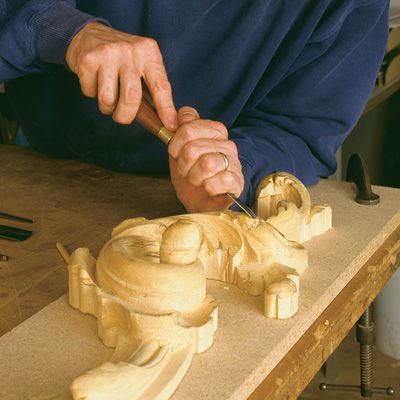Tools for Carving
Getting started doesn't need to be confusing or cost a fortune
Synopsis: Professional carver Ian Agrell starts with questions when suggesting what tools to buy: What sort of carving do you want to do? What size? What woods? Then he gets down to which tools are best. He avoids buying sets, saying one or two pieces in them are always unnecessary. You can always add more. He talks about where to find them and which tool types to start with. He finds straight gouges, V-parting tools, fishtail, and spoon gouges the most helpful, but he includes a complete list of what you should get. He explains section and size numbers, how to drive carving tools, and how to store them.
I’ve been carving wood for 34 years and teaching others for 18, so I’m often asked what tools to buy for woodcarving. My standard reply consists of a few questions of my own: What sort of carving do you want to do? What size? What woods? The answers to those questions will help determine the tools a carver will need.
A beginning carver can get by just fine with a few general-purpose tools (see the box on p. 82). As a rule, I would avoid buying a prepackaged set. No matter what the quality of the tools, usually one or two are a waste of space and negate the savings of buying them as a set.
High-quality carving tools, well-looked after and properly used, will last a lifetime and more—some of mine are more than 150-years old. Buy the best, and buy just a few tools at first. You can always add more when you need them. That way, you don’t end up with tools you’ll never use.
Where to find them
Carving tools are readily available at woodworking stores and in mail-order tool catalogs. Of the current offerings, I prefer the Pfeil tools (marked “Swiss, made” on their handles), distributed in the United States by Woodcraft (210 Wood County Industrial Park, P.O. Box 1686, Parkersburg, WV 26102-1686; 800-225- 1153). I think they’re the most refined carving tools made today. This is especially obvious in the smaller sizes, which are lighter and better machined than any of the others generally available.
The second-hand market also is a useful source of tools. At any decent-sized flea market, you can usually find someone selling these tools. If you research current prices before you go tool hunting, you’re more likely to get a good deal. You should be able to find good second-hand tools for half, or less, of what they cost new. The best tools were made by Addis and Herring Bros., but neither of these companies has been in business for years.
Homemade or custom carving tools also can be superb. I have some that were made about 100 years ago. They are light, delicate and well-made. Homemade tools often can be found at flea markets and used-tool dealers right alongside the commercial offerings, or you can have them made for you (there are a number of specialty forges).
You can learn to make your own carving tools by reading toolmaking books or by attending courses on the subject. Homemade tools are an especially attractive option when you need a specific chisel for a particular carving. I have some excellent fishtails that are very handy—I’ve never seen any comparable ones available commercially.
From Fine Woodworking #122
For the full article, download the PDF below:
Fine Woodworking Recommended Products

Veritas Micro-Adjust Wheel Marking Gauge

Stanley Powerlock 16-ft. tape measure

Bahco 6-Inch Card Scraper




















Log in or create an account to post a comment.
Sign up Log in